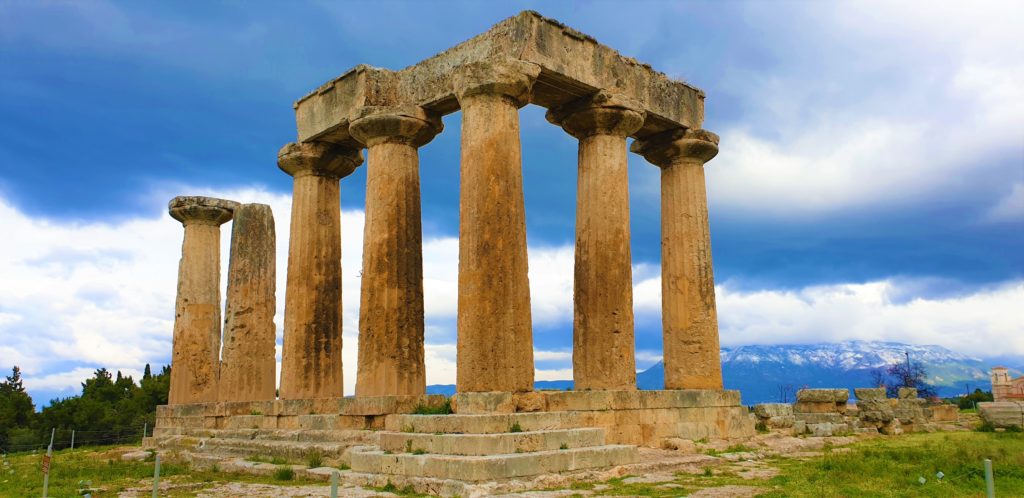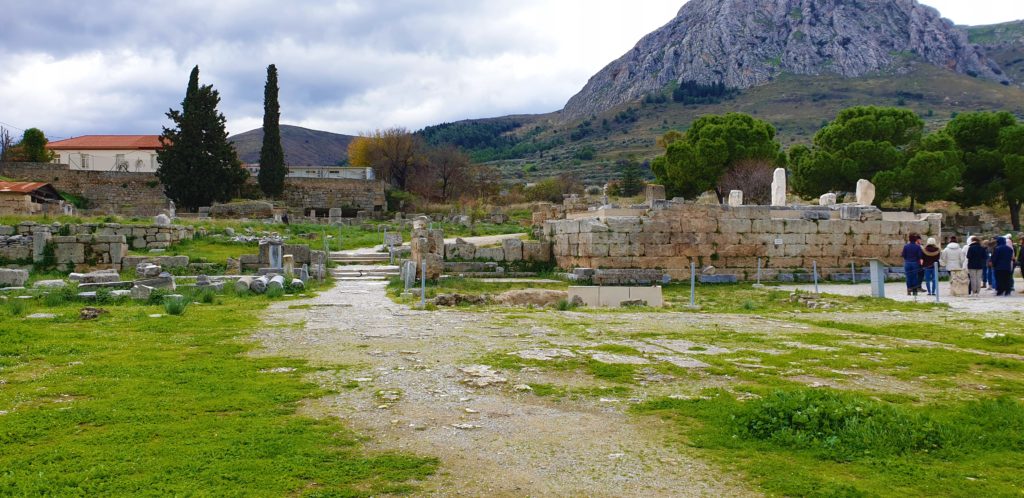Ancient Corinth is a very good day trip from Athens. From Athens it takes about 1 hour and 15 minuted by car. Ancient Corinth is worthy of a visit for several reasons.
Firstly it’s very interesting in trying to understand the life in the this rich city. It was a very multicultural city because of the Corinth Canal. It’s true it wasn’t navigable till the end of the 1800 so ships had to be transported to the other side and they prefered this option rather than navigate all around the Peloponnese Region. You can see how the Corinth Canal is now, watching the video below:
Ancient Corinth is also linked with the Apostle Paul who lived and preached in the city for several time.
In order to enjoy more the visit we examine a few information about the Ancient Corinth.
What are the characteristics of the Ancient Corinth? What was life like there? You’ll discover it while reading this post.
Outside the walls of Ancient Corinth
Ancient Corinth covered a range of 900 km2 because there wasn’t only the main city but also many smaller settlements.
Already from the 8th c. B.C., it was a rich and a powerful city-state especially due to two ports:
- At Lechaion in the Corinthian Gulf
- At Kenchreai from the side of the Saronic Gulf
Ancient Corinth and its reign
East
The eastern region of Corinthia was relatively underpopulated. The most important settlement of the region must have been Solygeia, close to the modern village Galataki.
North
The most northern settlement of Corinthia was Krommyon, close to the modern village Ayoio Theodoroi. According to myth, this is where Theseus killed the dangerous sow, Phaia.
Corinthian Identity
Corinth consisted of dozens of settlements, small and large. But what did their residents have in common?
These people drew their common descent from the Dorians. And of course, they shared a common language and alphabet.
Ancient Corinth was built at the foot of the Acrocorinth, a majestic hill, dominating the landscape.
The home’s life in Ancient Corinth
In ancient Greece private buildings were usually humble structures unlike many public magnificent constructions.
Households were run by women. They were responsible for raising their children and supervising the slaves, who were given the heaviest duties in the house.
Men were usually absent. mainly occupied with political and professional engagements.
Visiting the Ancient Corinth you easily understand how the women’s habits were very similar to ours. In the museum you can see face care sets, such as profumes and cosmetics, hair accessories and eyebrow tweezers.
Gods Venerating And Heroes
The Corinthians worshiped Aphrodite, Athena, Apollo, Demeter, Kore, Hera and Poseidon. Hero cult was a distinctive aspect of ancient Greek religious life.
Heroes, men who had showed remarkable activity during their lifetime, were honored after their death with rituals performed at their tombs or at an open-air sanctuary. Heroes’ sanctuaries were built along side roads or over older graves.
A temple dedicated to Apollo
The Temple of Apollo is the archaeological site biggest monument. The temple was built in the 6th c. B.C., when Corinth was at its zenith, on the site of an earlier temple. It was constructed from the local poros limestone.
The temple is in Doric order and originally had six columns at each end and fifteen along each side. Notable characteristics of its archaic date include the great length of the temple relative to its width, the large monolithic columns, and the squat, widely flaring capitals. Although most of this mid-6th century B.C. building has been destroyed, the bedrock preserves cut-tings made to receive the foundation blocks and thus allows a reconstruction of the temple’s plan.

The main part of the temple (sekos) was split into two non-communicating rooms. The roof was decorated with colorful architectural elements.
The interior of the temple consists of a porch at either end and a long central part (the cella) divided into two rooms by a cross wall. The traditional reconstruction of the plan makes this cross wall a solid wall and provides access to the western room of the cella through the western door.
The seven standing columns of the Archaic temple are one of the most prominent landmarks of Corinth.
The Acrocorinth: The sanctuary of Demeter and Kore
Demeter and her daughter, Kore or Persephone, were worshiped in a large sanctuary on the northern slope of the Acrocorinth.
In the 4th c. B.C., a small theater was carved into the rock. Three small temples were also built in the Roman Period.
Odeum & theater of Ancient Corinth
The theater was a place in which dramatic and musical events were staged. In the roman period staged fighting was added.
The theater has several phases. The original structure was built late in the 5th c. B.C. and had permanent seats but only a wooden stage building.
This was supplemented with a new orchestra and stage structure in the Hellenistic period.
In later antiquity theatrical tastes changed and the orchestra was converted into a gladiatorial arena.
Ancient Corinth and Cristianity
Ancient Corinth is also important because is linked with apostle Paul’s or Apostle of the Nations. Paul lived and preached in Corinth. When you visit the ancient Corinth you can also see the famous Bema.

This was likely the tribunal were Paul was brought for judgment before the proconsul Lucius Junius Gallio Annaeanus. He was accused of illegal proselitism and they brought him in the tribunal or bèma.
Because of its position the bema was used to speak to the crowd. Not only the Ancient Corinth has a bema. In the ancient greek cities it was in fact common to meet in front to a Bema.
Video
Watch the following video and Subscribe to our YouTube Channel if you aren’t already subscrided! Subscribe here!
Related Posts
Related Posts: